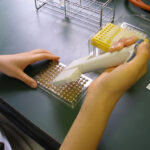The European Environment Agency (EEA) has recently published a briefing detailing the impact of veterinary antimicrobials on Europe’s environment. Positive developments are to be applauded, however they do not tell the whole story.
The use of antimicrobials for farmed animals and in aquaculture decreased by around 28% between 2018 and 2022. Nonetheless, the rate of antimicrobial resistance continues to rise around the world, including as an important cause of death in the European Economic Area (the EEA includes all EU countries, as well as Norway, Lichtenstein, and Iceland). At present, antimicrobial-resistant infections are estimated to caused 35,000 deaths per year in the European Union. For reference, in the EU, traffic accidents cause around 20,000 deaths per year.
A large number of EU guidelines, policies, and regulations attempt to control and monitor the use of antimicrobials in food-producing animals. This makes the regulatory landscape somewhat confusing, especially that many implementation details are still left to the states.
 Figure 1. Overview of the EU regulatory framework applicable to antimicrobials used in food-producing animals
Figure 1. Overview of the EU regulatory framework applicable to antimicrobials used in food-producing animals
One of the results of unequal implementation is that there is no standardized way of tracking the actual use of antimicrobials in food-producing animals. To collect the numbers, the EEA has used proxy numbers, especially antimicrobial sales data and self-reported data. With such broad strokes, it is to be expected that the actual figures might be higher.
Lower numbers…
According to the European Surveillance of Veterinary Antimicrobial Consumption (ESVAC) database, in the European Economic Area countries, plus Switzerland and the UK, total antimicrobial consumption for farmed animals and aquaculture was estimated at 73.9 mg/PCU* in 2022. This signifies a 30% reduction over 5 years.
In numbers: 4,458 tons of active substances were sold in one years for farmed animals & aquaculture.
*PCU represents a population correction unit (PCU). The PCU takes into account the population and relative weight of animals and “is used the normalize antimicrobial sales data for the size of the animal population that could potentially be treated with these substances. Using this methodology, 1 PCU corresponds to 1 kilogram of animal biomass”.
…But higher risks
In 2021, total antimicrobial consumption in humans – measured in 28 European countries – was estimated at 125.0 mg/kg. This number has unfortunately not gone down. What is worse: a much larger volume of antimicrobials is sold for food-producing animals than for human medicine. Which means that, relative to the total population, the impact of veterinary-use antimicrobials remains disproportionately large.
Moreover, two outliers (Poland and Lithuania) exhibited a worrying increasing trend, showing that no good development is irreversible. The EEA also highlights this danger, in the context of growing global consumption of animal protein. Increased demand “may put pressure on farmers to adopt intensive production practices that require increased use of antimicrobials”. The use of antimicrobials elsewhere in the world may lead to impacts in Europe, “not just by theoretically exposing consumers to antimicrobial residues but also by contributing to rising global rates of drug-resistant pathogens and infections”.
 Figure 2. Sales by EU Member States in 2018 vs. 2022
Figure 2. Sales by EU Member States in 2018 vs. 2022
Because of declining livestock populations in the last few years, while demand remained constant, EU-27 imports of animal products more than doubled between 2002 and 2022. There are no reliable global data on the veterinary use of antimicrobials, however it is generally believed that over 70% of antimicrobials sold globally may be used in for animal protein production.
Data collected by the World Organization for Animal Health (WOAH) from its member countries suggest that, between 2017-2019, “the use of antimicrobials in animals decreased by 25% in the Asia, Far East and Oceania regions, while it increased in Africa (+45%) and the Americas (+5%). Despite these partial improvements, a recent study forecasted that global use of antimicrobials in food-producing animals could rise by 8% in 2030, compared to 2020 levels (Mulchandani et al., 2023)”.
Quick summary
Reduction in Antimicrobial Use: There has been a significant reduction in the use of antimicrobials in farming and aquaculture across the EU. From 2018 to 2022, there was a decrease of approximately 28%, which aligns with the EU’s Farm to Fork strategy targeting a 50% reduction by 2030.
Antimicrobial Resistance (AMR): Despite the decrease in use, antimicrobial resistance remains a severe public health threat, causing an estimated 35,000 deaths annually in the European Economic Area. The resistance is attributed to the use of antimicrobials, which – as has been widely documented and discussed – can promote the evolution of resistant microorganisms.
Environmental Impact: The briefing underscores significant knowledge gaps in monitoring antimicrobial residues, resistant bacteria, and resistance genes in the environment. Improved surveillance could help identify pollution hotspots and assess the impact of reduction measures.
Regulatory and Policy Framework: The EU has implemented several policies to regulate the use of antimicrobials, including banning their use as growth promoters and setting stricter conditions for prescriptions. These measures are crucial for managing the risk of AMR.
Further efforts are needed to decrease the reliance on antimicrobials in food production. These include enhanced monitoring, promoting alternative practices in animal farming, and better animal welfare and biosecurity measures.
While improvements are clear and commendable in the EU-27 states, increased antimicrobial usage in some EU countries and in various areas around the world represent a significant concern.
For further details on the use of veterinary antimicrobials in Europe’s environment, you can refer to the EEA’s full report.














